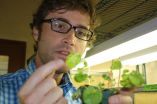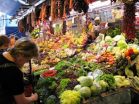(Press-News.org) Scientists trying to get a grip on the arms race between plant-eating insects and the defenses put up by their hosts just got a boost from new research by a University of Arizona entomologist published in the early view edition of Molecular Ecology.
Noah Whiteman, an assistant professor in the UA's department of ecology and evolutionary biology, has found a miniature ecosystem consisting of a plant and a tiny fly that spends its entire life cycle on the plant.
What makes this system special is the fact that both its key players – the plant and the insect – are what scientists call genetically tractable model organisms: holy grails of any serious science that aim to unravel biological mechanisms down to the level of genes and proteins and signaling molecules.
Decades of research and knowledge rest upon two of the most famous and widely used workhorses in genetics research: Arabidopsis thaliana, an unassuming, weedy plant in the mustard family, and Drosophila melanogaster, familiar to many as the tiny, red-eyed fruit flies hovering around the produce aisle.
However, until now, scientists wanting to study interactions between plant-eating insects and the plants they befell were out of luck: Fruit flies, as the name implies, feed on rotting fruit and couldn't care less about Arabidopsis plants, and vice versa.
Enter Scaptomyza flava, a fly so closely related to Drosophila melanogaster it shares most of its genes, and with a strong appetite for Arabidopsis. Female Scaptomyza flies prick a hole into the plant tissue and lay their eggs inside. Once the larvae hatch, they spend their childhood as leaf miners: tunneling their way through the leaf, munching on the nutritious plant tissue.
A fruitful walk in the field
Although the science underlying plant-insect interactions is no walk in the park, Whiteman's discovery started out as just that.
While a postdoctoral research fellow at Harvard, Whiteman became frustrated by the lack of a model system to study plant-insect interactions on a genetic and molecular level.
After an extensive literature search, he went out into the field and started looking for mustard plants that had flies living in and on them.
"One of the first places I started to look was Fresh Pond, which provides a lot of the water supply for Cambridge. There was a vacant lot so I pulled up my car and looked for yellow flowers. And sure enough, there was this plant called Barbarea vulgaris growing there, which is introduced from Europe and closely related to watercress."
"I looked for mines in the leaves. I brought some leaves and larvae to the lab, wrapped them in paper towels, put them in cages and let them go."
Eventually, flies started coming out. Some of them had red eyes.
"I keyed them out and they turned out to belong to the genus Scaptomyza, an outdated classification because we now know they belong to the Drosophila genus. 'This is exciting,' I thought. I put them all in a cage with Arabidopsis plants. They started attacking the plants; not only the larvae, but the adult females, too. They make holes in the leaves with their ovipositors and drink the juices that come out."
Then, one day, while walking his dog in one of Boston's oldest city parks, Whiteman again came across the plants with the telltale tunnels in their leaves.
"I found the same plant there and the same flies in it. There were actually two Scaptomyza species coming out of this plant. One is a true herbivore and was making the mines, and the other was living in the mines of the miner. I sent the flies to the Smithsonian USDA Insect Identification Lab for confirmation but they sent them back and said, 'There is nobody here who could identify this.'"
"There seems to be this idea that there is this big convention where people decide what becomes a model organism, when in fact it's just individuals who decide what can be collected and what will work. The problem with these flies is you can't freeze the eggs, you can't store them. You need to keep things alive."
Sharing a hotel room with flies
When Whiteman traveled across the country to join the faculty at the UA, the flies traveled with him.
"I kept them in the back of my car, in cages. I was bringing them into hotel rooms."
Next, Whiteman's research group had to show that the flies and Arabidopsis plants could be used as a model system.
"There is a lot of research going on trying to figure out what biochemical pathways plants use to cope with insect attacks," said Whiteman. "Now we can tackle these questions in much more detail."
As one might expect, over the course of evolution, host plants have developed numerous ways to ward off parasites, such as chemicals that are toxic to the insects or throw a wrench into their development in some way.
Whiteman and his coworkers found that Arabidopsis plants ramp up their production of proteins that mess with the insects' digestive tract.
"The idea is that the plant is making it difficult for the insect to digest it," Whiteman explained. "It's very complicated, we don't really know what's going on at a molecular level."
To address this question, the researchers compared how well larvae fared on defenseless, mutant plants unable to make the indigestive proteins compared to their kin raised on wild-type plants.
"From those analyses, we do know that it has an effect on the larvae; they don't do as well," Whiteman said. "The plants put up their defense in response to the insects being present. If you're a fly, living on something that is trying to kill you is different from living on, say, a rotting apple," Whiteman said.
"We also know that once a plant turns on one defensive pathway, others shut down. They inhibit each other," he added. "To the ecologist this is confusing, but of course, you can't be good at everything at the same time."
"Until now, we weren't able to tease these mechanisms apart, to answer questions like, why is this insect feeding less? We didn't have any tools to study these interactions in a controlled fashion."
"You could put any plant-eating insect on Arabidopsis to study this interaction from the plant side," he said. "In order to make our new model system compelling from the insect side, we had to use some tools from Drosophila genetics."
Hunting down defense genes
His team tested the Scaptomyza flies for the activity of genes known from Drosophila to be important in dealing with toxic plant compounds, and how they responded to the presence or absence of specific host plant defense molecules.
The researchers found that when they reared larvae in knockout plants unable to produce defense molecules, the flies dialed back their expression of detoxification genes.
"It makes sense for them to not turn on those genes unless the plant's defenses are up," Whiteman said.
Conversely, putting larvae on plants with intact defenses turned on their detoxification genes.
To put the new model system on a broad basis, Whiteman and his colleagues determined the genetic code of all the active genes in larvae reared on plants with different abilities to fend off insects.
"Now we have a couple of billion of base pairs of data, and our goal is to identify genes that are selectively induced or repressed in larvae depending on what kind of plant they are reared on," he said. "We found 400-500 significantly induced ones."
As often in ground-breaking research, the initial discovery stirred up a myriad of questions.
"Now we have to figure out, are those genes functionally important?" Whiteman said. "We can show that there is resistance in Arabidopsis and we can identify which pathways are involved in that resistance. The next question is: How is the leaf miner responding to the presence or absence of these toxic molecules? Does it care? Clearly, it does. There is a cost for detoxifying, but what is it?"
Ecological questions are waiting to be answered as well.
"We know that the leaf mining habit has evolved probably 25 times in insects," Whiteman said, "mostly in beetles, butterflies, moths, some wasps and saw flies. It's not present in the other insect orders, but why? How has selection shaped the ability of these insects to colonize an organism with a potent defense response? We want to develop the Scaptomyza lineage as a system for answering questions like these. This is our lab rat system."
INFORMATION:
A pdf of the paper is available at http://onlinelibrary.wiley.com/doi/10.1111/j.1365-294X.2010.04901.x/pdf
Walk in the park yields biological treasure
A newly identified relationship between a fly and a weedy mustard-type plant promises to answer many long-standing questions surrounding the evolutionary arms race between plant-eating insects and their host plants
2010-11-20
ELSE PRESS RELEASES FROM THIS DATE:
Kidney disease patient health: Moderate alcohol and calcium help, obesity harms
2010-11-20
1. Moderate Drinking Benefits Kidney Transplant Recipients
Modest Amounts of Alcohol Prevent Diabetes and Premature Death
Moderate alcohol consumption reduces one's risk for diabetes and premature death in the general population. To find if the same were true for stable kidney transplant recipients, Dorien Zelle (University Medical Center Groningen, the Netherlands) and her colleagues studied 600 renal transplant recipients who had their transplant more than one prior and followed them for several years post-transplant. Of these, 288 (48%) were abstainers, 94 (16%) ...
Race impacts declining kidney function
2010-11-20
African Americans—along with some groups of Hispanics—have faster rates of decline in kidney function compared to white Americans, according to a study presented at the American Society of Nephrology's 43rd Annual Meeting and Scientific Exposition.
"Racial/ethnic differences are present early, before chronic kidney disease (CKD) has been established," comments Carmen A. Peralta, MD (University of California, San Francisco).
Based on a large nationwide study of heart disease risk factors (the Multi-Ethnic Study of Atherosclerosis), the researchers analyzed data on ...
Earlier specialist care associated with lower incidence of ESRD and better patient outcomes
2010-11-20
Among kidney disease patients, earlier care from a nephrologist is associated with a decreased likelihood of developing end-stage renal disease and a lower risk of death during the first year of dialysis, according to a study presented at the American Society of Nephrology's 43rd Annual Meeting and Scientific Exposition.
Although confirmatory studies are needed, increasing the number of patients who receive nephrologist treatment for advanced chronic kidney disease (CKD) could have a substantial impact on the currently high U.S. ESRD rates as well as improve outcomes ...
Elderly can blame fractures and falls on low sodium
2010-11-20
Older adults with even mildly decreased levels of sodium in the blood (hyponatremia) experience increased rates of fractures and falls, according to a study presented at the American Society of Nephrology's 43rd Annual Meeting and Scientific Exposition. Falls are a serious health problem for the elderly and account for about 50 percent of deaths due to injury in the elderly.
"Screening for a low sodium concentration in the blood, and treating it when present, may be a new strategy to prevent fractures," comments Ewout J. Hoorn, MD, PhD (Erasmus Medical Center, Rotterdam, ...
New tests and interventions may help prevent future health problems
2010-11-20
1. Potassium Citrate May Help Prevent and Treat Osteoporosis
Supplement Neutralizes Bone Damage Inflicted by the Western Diet
The Western diet creates an acidic environment in the body that removes calcium from bones and may contribute to the development of osteoporosis. Healthy adults who consume the standard US diet sustain a chronic, low-grade state of acidosis that worsens with age as kidney function declines, limiting urinary acid excretion. Reto Krapf, MD (University of Basel, in Bruderholz/Basel, Switzerland) and colleagues designed a study to see if daily alkali ...
LA BioMed research finds kids with larger waist sizes are more likely to have cardiac risk factors
2010-11-20
LOS ANGELES (Nov. 19, 2010) – In a study of more than 4,500 children, researchers found those with higher waist circumferences had significantly higher pulse pressures, which is known to increase the risk of heart-related disorders, according to an abstract presented today at the American Society of Nephrology's Renal Week conference in Denver.
Gangadarshni Chandramohan, MD, a researcher at Los Angeles Biomedical Research Institute at Harbor-UCLA Medical Center (LA BioMed) and the lead author of the abstract, said the research team studied data from 4,667 children aged ...
COPD could be a problem with autoimmunity
2010-11-20
Moderate to severe chronic obstructive pulmonary disease (COPD) may be an auto-immunity problem, according to researchers in Spain, who studied the presence of auto-antibodies in patients with COPD and compared them to levels of control subjects. They found that a significant number of patients with COPD had significant levels of auto-antibodies circulating in their blood, about 5 to 10 times the level in controls.
The findings were published online ahead of the print edition of the American Thoracic Society's American Journal of Respiratory and Critical Care Medicine.
"We ...
Report: For every 1 homeless person in Canada, another 23 live in inadequate housing
2010-11-20
TORONTO, Nov. 19, 2010--For every one person in Canada who is homeless, another 23 live in unsafe, crowded or unaffordable housing, meaning the country's housing crisis is even worse than previously thought, according to Dr. Stephen Hwang of St. Michael's Hospital in Toronto.
Those "vulnerably housed" people have the same severe health problems and dangers of assault as homeless people, said Hwang, principal investigator of a new report on housing and health issues in Vancouver, Toronto and Ottawa.
"The key point is that Canada needs a national housing strategy," ...
Eating a variety of fruit cuts lung cancer risk
2010-11-20
Eating five portions of fruit and vegetables per day is one of the means that experts most frequently recommend for preventing cancer. Now, the European EPIC study carried out by researchers from 10 countries has shown that, in the case of lung cancer, the important thing is not just the quantity but also the variety of fruit consumed, which can reduce the risk by up to 23%.
"This research looks more deeply into the relationship between diet and lung cancer", María José Sánchez Pérez, co-author of the study and director of the Granada Cancer Registry at the Andalusian ...
Special section on ecological distribution conflicts in the journal Ecological Economics
2010-11-20
Researchers from Institute of Environmental Science and Technology (ICTA), at Universitat Autònoma de Barcelona (UAB), and other universities have published a special section in the journal Ecological Economics that analyzes the link between ecological economics and political ecology. This issue stems from the institute's research on impacts and resistance at the "commodity frontiers", where the extraction of natural resources and the disposal of toxic wastes produce a range of economic, environmental, cultural and social conflicts.
The special issue, titled Social Metabolism, ...
LAST 30 PRESS RELEASES:
Mental trauma succeeds 1 in 7 dog related injuries, claims data suggest
Breastfeeding may lower mums’ later life depression/anxiety risks for up to 10 years after pregnancy
Study finds more than a quarter of adults worldwide could benefit from GLP-1 medications for weight loss
Hobbies don’t just improve personal lives, they can boost workplace creativity too
Study shows federal safety metric inappropriately penalizes hospitals for lifesaving stroke procedures
Improving sleep isn’t enough: researchers highlight daytime function as key to assessing insomnia treatments
Rice Brain Institute awards first seed grants to jump-start collaborative brain health research
Personalizing cancer treatments significantly improve outcome success
UW researchers analyzed which anthologized writers and books get checked out the most from Seattle Public Library
Study finds food waste compost less effective than potting mix alone
UCLA receives $7.3 million for wide-ranging cannabis research
Why this little-known birth control option deserves more attention
Johns Hopkins-led team creates first map of nerve circuitry in bone, identifies key signals for bone repair
UC Irvine astronomers spot largest known stream of super-heated gas in the universe
Research shows how immune system reacts to pig kidney transplants in living patients
Dark stars could help solve three pressing puzzles of the high-redshift universe
Manganese gets its moment as a potential fuel cell catalyst
“Gifted word learner” dogs can pick up new words by overhearing their owners’ talk
More data, more sharing can help avoid misinterpreting “smoking gun” signals in topological physics
An illegal fentanyl supply shock may have contributed to a dramatic decline in deaths
Some dogs can learn new words by eavesdropping on their owners
Scientists trace facial gestures back to their source. before a smile appears, the brain has already decided
Is “Smoking Gun” evidence enough to prove scientific discovery?
Scientists find microbes enhance the benefits of trees by removing greenhouse gases
KAIST-Yonsei team identifies origin cells for malignant brain tumor common in young adults
Team discovers unexpected oscillation states in magnetic vortices
How the brain creates facial expressions
Researchers observe gas outflow driven by a jet from an active galactic nucleus
Pitt student finds familiar structure just 2 billion years after the Big Bang
Evidence of cross-regional marine plastic pollution in green sea turtles
[Press-News.org] Walk in the park yields biological treasureA newly identified relationship between a fly and a weedy mustard-type plant promises to answer many long-standing questions surrounding the evolutionary arms race between plant-eating insects and their host plants


